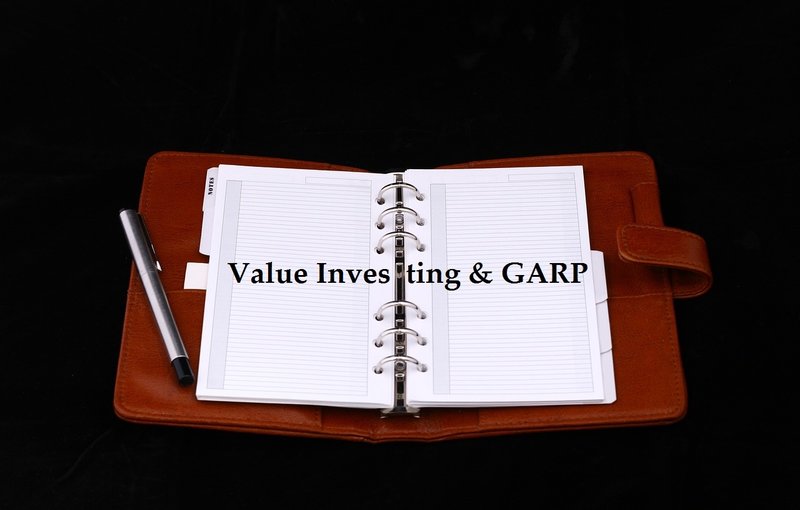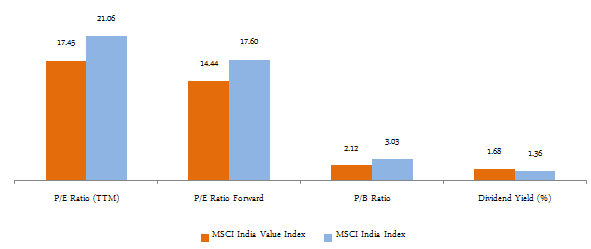Investment Styles: Value Investing and GARP

In our post, Understand investment styles to make smarter decisions: Growth Investing, we had discussed that, the name of a mutual fund scheme can reveal useful information with regards to the investment style of the fund manager. We had discussed that, fund managers employ two broad types of investment styles, Growth Investing and Value Investing. In the growth investing style, investors or fund managers invest in companies, where they expect higher than average revenue and earnings (EPS) growth. Since growth stocks experience faster EPS growth relative to the market, their prices can rise faster than other stocks. At the same time, we had also discussed that, in a momentum driven market like India, valuations of growth stocks can run ahead of themselves and therefore, these stocks can see sharp fall in share prices during corrections.
In our previous post, we had also discussed the various characteristics of growth stocks and if they are suited to your investment temperament. In this post, we will discuss about value investing and an investment style that blends characteristics of both growth and value investing (GARP).
Value Investing
In Value Investing style, investors or fund managers try to identify companies which are trading at prices which are significantly below their fair price. In other words, value investors invest in companies, which they are believe are undervalued. You may think how can a stock be undervalued? As per Eugene Fama’s Efficient Market Hypothesis, the market discounts all information about companies in the share prices. You should understand that, in capital markets there are beliefs (or theories) and counter beliefs (or counter theories). If Fama’s Efficient Market Hypothesis was true then, it is not possible for fund managers to beat the market. Yet, as many of our readers probably know, Warren Buffett has consistently beaten index funds for a long period of time. Warren Buffet believes that, "there is much inefficiency in the market" and "value investors have successfully exploited gaps between price and value".
Value investors seek stocks with lower than average Price to Earnings (P/E ratio) or lower than average Price to Book (P/B ratio) or higher than average dividend yields. In the chart below, you can see that, the Price to Earnings ratios (both trailing twelve months and forward) and Price to Book ratio of MSCI India Value Index (index of value stocks) is lower than those of MSCI India Index (index of both growth and value stocks), while the dividend yield of MSCI India Value Index is higher than that of MSCI India Index.

As discussed earlier, value investors believe that, the market can be irrational and over-react to good news or bad news. For example, one off poor quarterly earnings by a company can cause investors to sell large volumes of the company’s shares causing it to be underpriced. Similarly, the market can over-react to some economic, legal or political developments. The value investors compare the market valuations of companies with lower than average P/E or P/B) with their fair valuation and see if there is a significant price value gap. Value investors expect that, the market over a period of time will discover the fair value and give the stock its correct valuation, in the process rewarding investors who bought the under-valued stock with superior returns.
Challenges of Value Investing
The biggest challenge of value investing is estimating the fair value. Estimating the fair value of an underpriced stock is both art and science. Value investors are contrarians. To determine fair value, fund managers estimate future cash flows of the company, which is usually a difficult task for under-valued companies because past performance will not give you the true picture and the fund managers need to make judgements about future growth. Though value investing can potentially give superior long term returns, it is more difficult than growth investing.
Warren Buffett, the most famous value investor in the world, in his lecture in Columbia University said that, value investors should think in terms of investing in a business and not in a stock. What he means is that, value investing requires deep knowledge of the business and the industry sector. In my opinion, only very experienced fund managers, with a long track record of outperformance, are likely to be successful value investors. Therefore, if you are investing in value funds, you should check the performance track record of the fund manager; in fact, you should check the performance track record of the fund manager for all mutual fund investments, but it is especially important for value funds.
Does Value Investing work in India
The conventional belief is that, India is a growth market (till 2014, the 10 year Nifty EPS CAGR was above 13%) and therefore growth investing is the preferred investment style. Some market observers think that, Indian investors are less patient, want returns faster and do not care about investment styles, as opposed to foreign investors who are more patient and strategy oriented. The clamour for growth in India leads to higher demand for growth stocks, which in turn results in higher prices and returns.
Sankaran Naren, CIO ICICI Prudential Mutual Fund, has a different take on the prospects of value investing in India. In his interview to Advisorkhoj, Naren told us that, “we have always believed that although the India is a growth market value investing has a good chance of success. Why we believe is because lot of money invested in equities in India is invested with a growth view. By chance a growth stock becomes a value stock people stamped for the lower end of the growth stock and few amount of money which is lying in value products are the only people who can actually buy these stocks at the price decided by the growth investors”. Naren further says, “The experience of the value funds in the market has been inverse and in our opinion whenever markets are polarized in valuations like 2007 and 2012 they actually have benefited value funds because the value funds avoid the fact which are overvalued like infrastructure in 2007 and the high quality names at this point of time”. Naren told that, value investing worked for more than “5 decades in a country like America which also was a growth market and which has also seen periodic big rallies in select sector which value funds are avoided”. Naren’s views are supported by the long term returns of some top performing value funds, which have been higher than even the many top performing growth funds.
Value investing success factors
Warren Buffett once said that, success in investing does not correlate to high IQ (intelligence). Once you have the basic intelligence, Buffett says, “What you need is the temperament to control the urges that get other people into trouble in investing.” We keep quoting Warren Buffett in this post, because he is most iconic value investors in the world. One fund manager, schooled in value investing, once told me that, two things are of utmost importance for value investors.
- Value investing requires a patience if you want to get the best results. I stress patience, because it does not come naturally to many Indian retail investors. Patience is an important Warren Buffett characteristic. Value funds may underperform for a period of time, but if you are patient, you are likely to get rewarded handsomely.
- Value investors need to have an absolute return mindset. This is another Warren Buffett characteristic. What you ultimately get from your investment is the absolute return. Relative return versus benchmark or peers is useful for comparison, but it may lead to you make reactive and often wrong investment decisions.
As discussed earlier, identifying good value stocks is difficult. Searching for value stocks in the market can lead you to a value trap, where you buy a cheap stock but its share price never goes up. While we will not take names, there are countless value trap examples in our market. When you fall in a value trap, even though you bought cheap, you have to sell cheaper. In our view if you want to invest in good value stocks, the best option for retail investors is to invest in good value mutual fund schemes.
Growth at a Reasonable Price (GARP)
We had discussed about growth investing in our previous post and about value investing in this post. If you have understood how growth and value investing work, then you will able to understand the third investment style, which has been increasingly gaining currency among many mutual fund managers in India, Growth at a Reasonable Price (GARP). GARP combines tenets of both growth and value investing. GARP investing was popularized by legendary fund manager, Peter Lynch of Fidelity. GARP investors look for stocks with good earnings growth potentials, but they are, at the same time, wary of stocks which are trading at very high valuations.
While to some readers, GARP may seem to combine the best of both worlds, in our opinion, it is another investment style, like Growth or Value Investing. In a high growth market like India, GARP can work, because at times the momentum carries the market into territories, where valuations of certain growth stocks can get stretched. In bull markets growth stocks may outperform GARP stocks which in turn can outperform value stocks. In bear markets, GARP stocks can outperform growth stocks, but give lower returns than value stocks.
Critics of GARP investing say that, GARP investors are neither here nor there. They say that, the GARP style may fail to define a robust stock picking approach. However, this criticism is not justified; good fund managers following the GARP style form well defined criteria for picking up GARP stocks. Like growth investors, GARP investors look at EPS growth over the past few years and growth projections for the next few years, however, unlike growth investors, GARP investors are cautious about very high growth forecasts. GARP investors see if valuations (P/E ratio) are reasonable for what they think are pragmatic growth forecasts. An important financial metric that GARP investors look at is Price / Earnings to Growth (PEG) Ratio. PEG is the ratio of the P/E ratio and the Earnings Growth. GARP investors usually avoided companies, where PEG is higher than 1.
There is a fair amount of subjectivity in developing GARP strategies. It requires experience and expertise to form highly successful GARP strategies and therefore, investors should look at the performance track record of GARP fund managers, before making their investment decisions. Top performing mutual funds employing GARP strategy has given excellent returns over different time-scales, but GARP works best over long investment tenures.
Conclusion
Different fund managers have different investment styles. Historical data has show that, all three investment styles can create wealth for investors over long investment horizon. Whether you invest in growth funds, value funds or GARP funds will depend on your investment preferences. You can also have a mix of growth, value and GARP funds in your portfolio to benefit from all three investment styles. In this two part blog post, we discussed about various investment styles. Armed with the knowledge of investment styles, you can evaluate for yourself, in consultation with your financial advisor, which mutual fund schemes are more suited to your needs.
Mutual Fund Investments are subject to market risk, read all scheme related documents carefully.
RECOMMENDED READS
LATEST ARTICLES
- Why you need to have hybrid mutual funds in your portfolio: Different types of funds Part 2
- Why you need to have hybrid mutual funds in your portfolio: Misconceptions Part 1
- Which is the best time to invest in mutual funds
- Economic slowdown: Is it real and what should you do
- Importance of liquidity in investing: Mutual funds are ideal solutions
An Investor Education Initiative by ICICI Prudential Mutual Fund to help you make informed investment decisions.
Quick Links
Follow ICICI Pru MF
More About ICICI Pru MF
POST A QUERY




